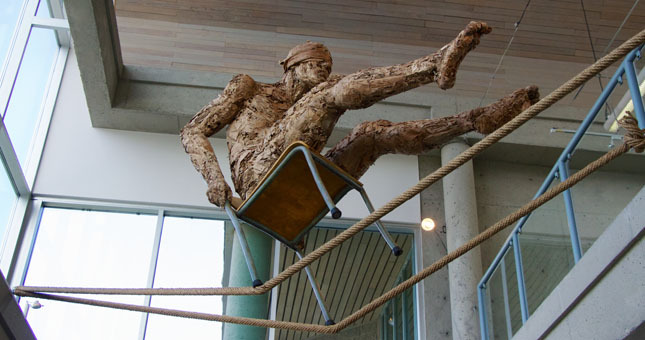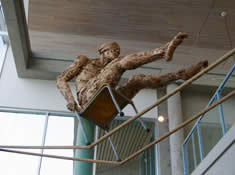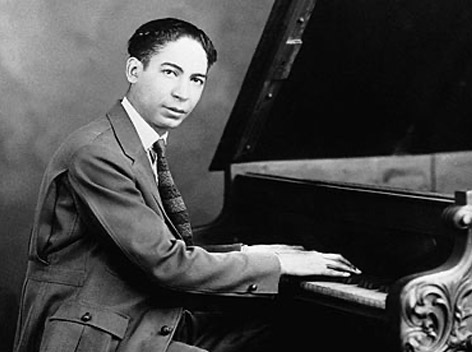
Chair by David Robinson; Photograph by Ken McAllister
A Chair Between the Past and the Future
On the weekend of October 25 and 26, 2013, a new Chair was established at Regent College. We acknowledged and honoured the contribution of Eugene and Jan Peterson to Regent College by establishing The Eugene and Jan Peterson Chair in Theology and the Arts with Professor Iwan-Russell Jones installed as the first incumbent. In attendance were a number of the donors who had contributed three million dollars to ensure, in the providence of God, that Regent’s commitment to the integration of the arts and theology would continue in perpetuity.
An academic chair is a vehicle that provides donors with an opportunity to sacrifice financially in an area of passion and interest. More importantly, it allows the institution to honour individuals who have had a significant impact on the life of the school. Finally, it places a faculty member in a position of authority and influence by speaking into an academic discipline ex cathedra, “from the chair.”
These events marked a particular moment in time for the arts at Regent College, providing a perspective on the past as well as an invitation into the future.
A move back into the early years of Regent College will reveal the presence of the arts represented in our Summer Programs with teaching from people like poet Margaret Avison and art historian Hans Rookmaaker. Space will not allow for a detailed account of the substantive contributions of Dal Schindell, Loren Wilkinson, and Laurel Gasque, along with Thena Ayres, Maxine Hancock, Duffy Lott Gibb, Ali Cumming, and many others. People from all around the world have been blessed in Summer courses by the teaching of theologian and musician Jeremy Begbie, writers Rudy Wiebe and Madeleine L’Engle, poets Luci Shaw and Scott Cairns, calligrapher Tim Botts, visual artist Chris Anderson, and actor Bruce Kuhn, to name just a few luminaries who have impacted Regent for good. This upcoming summer promises to be just as rewarding with courses taught contemporary artist Makoto Fujimura, playwright and actor Jeff Barker, Hollywood film producer Ralph Winter, and many more professional artists and distinguished scholars.
Rich soil provided by all these individuals has brought life to different types of students. Some have come to Regent quite unfamiliar with the arts and its impact, but have had their senses awakened. In preparing for work in the church, others have found Regent’s emphasis on the arts to be instructive and empowering as they have learned that pastoral preparation goes beyond formal theology. Serious artists who come to Regent with expertise in a particular genre often arrive with minimal theological understanding and yearn for the interdisciplinarity that is offered here, while others need the permission granted by this community to see their particular vocation as a viable call from God.
Apart from the more obvious manifestation of the arts through faculty and students, the list of other expressions is endless. The presence of an art gallery in the heart of the building, the fact that a number of professors allow artistic expression as a way to assess performance, the attention paid to the aesthetic component of Regent publications, concerts, and other artistic expressions in the atrium and the Chapel, and the physical attractiveness of the building along with the art throughout, all speak to Regent’s deep historical commitment to the arts.
Our celebratory weekend in October was a culmination of this rich history in the presence of Eugene, Jan, afnd Iwan—all of whom understand the inextricable link between theology and the arts in a secular and Christian culture where fragmentation pulls them apart. But the weekend was also an impetus to move ahead. It was a moment in time that called us back to our history while establishing a trajectory for the future. That future is well captured by my colleague, Emerita Professor Maxine Hancock, in her article, “What has Paris to do with Jerusalem (Or the Arts with Theology)” published in the Winter 2006 issue of Crux:
Theology guards art from heresy, blasphemy or idolatry. Theology is fundamentally explicatory and necessarily reductionistic in its method because it cannot hold all the mystery it describes. Art keeps theology from becoming abstract and unapproachable and allows for the necessary ambiguity around mystery. They work together. Art ornaments and expands as well as illustrates or provides analogies for theological concepts. At its best, it points by its very being to the argument for the existence and nature of God that is intrinsic in beauty and harmony itself. Without theology, art can easily lose its way; but without art, theology can lose its audience.





